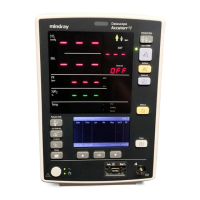Accutorr V Operating Instructions 0070-10-0699-02 3 - 19
Operation Alarms
NOTE: If the SpO
2
alarm high is set to OFF, the alarm OFF symbol
will display in the SpO
2
parameter tile.
Alarms occurring during the process of SpO
2
measurement include two (2) types:
physiological alarms and technical alarms. Physiological alarms occur when the patient’s
pulse rate or oxygen saturation level is equal to or exceeds set alarm limits. Technical alarms
are any SpO
2
-related alarms, which are not physiological, such as functional failures.
3.8.2 Alarm Violations
An alarm condition exists if the physiological parameter is equal to or exceeds the high/low
alarm limit. An alarm limit violation causes the following to occur:
• The alarm lamp flashes red for high priority alarms, and shows continuous yellow for
low priority alarms.
• The LEDs for the alarming parameter condition flash.
• The parameter in an alarm condition is in reverse video on the LCD Display (17).
• The alarmed parameters displayed in red on color display.
• The alarm tone sounds (unless silenced with (29)).
• The alarming parameter prints in parenthesis ( ) when printed on the recorder.
NOTE: If the message “ALARM DISABLED!” is shown on the LCD
Display (17), one or more alarms is OFF as shown for the
SPO
2
ALM HI in FIGURE 3-11. To view the alarm settings,
press (10).
Masimo SpO
2
Pulse Rate High
Adult
Pediatric
Neonate
Off, 27–240 bpm Off
Off
Off
1
Masimo SpO
2
Pulse Rate Low
Adult
Pediatric
Neonate
Off, 25–238 bpm Off
Off
Off
1
Nellcor SpO
2
Pulse Rate High
Adult
Pediatric
Neonate
Off, 22–250 bpm Off
Off
Off
1
Nellcor SpO
2
Pulse Rate Low
Adult
Pediatric
Neonate
Off, 20–248 bpm Off
Off
Off
1
Alarm Limit Table
PARAMETER RANGE UNITS
FACTORY
DEFAULT
UNITS OF
INCREMENT

